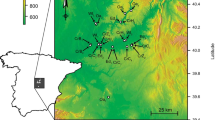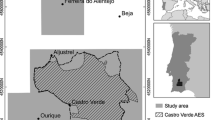Abstract
Despite the widespread need to predict and assess the effects of landscape change on biodiversity, the array of tools available for this purpose is still limited. Species’ patterns and human activities such as land use respond to the environment on their own suite of scales in space and time so that their interactions are overlapping but complex. It is difficult, therefore, to relate biodiversity to patterns described solely by metric assessments of spatial heterogeneity. In this methodological paper, we therefore propose consideration of two measures of landscape organisation which focus on the relationships between different properties of the landscape system (e.g., soil type distribution, land use distribution), rather than on their description alone. Alpha organisation measures the degree to which the distribution of features such as land use deviate from a random distribution, measured here as fractal dimension from the semivariogram of a variable describing agricultural intensity. Beta organisation measures the degree of deviation by which the spatial distribution of one property (e.g., human land use) is independent of the distribution of another (e.g., soil type) and was derived from relative mutual information (= redundancy) between the ‘agricultural land use’ and ‘soil types’. These measures are illustrated in a rural landscape of the lower Seine valley, at two scales of observation, and at two dates (1963 and 1999) separated by substantial agricultural change due the European Common Agricultural Policy (= CAP). The results show that analysis of patterns of agricultural activity across a range of spatial scales (α organisation), or across the pattern of spatial variation in soil types (β organisation) reveal how the agricultural actors respond to environmental constraints at different scales. This organisation concept relates to the metastability of landscape systems, and suggest possible correlation between high values of landscape organisation and high levels in biodiversity.
Similar content being viewed by others
References
Alard, D. and Poudevigne, I. 1999. Factors controlling plant diversity in a rural landscape: a functional approach. Landscape and Urban Planning 46: 29–39.
Antrop, M. and Van Eetvelde, V. 2000. Holistic aspects of suburban landscapes: visual image interpretation and landscape metrics. Landscape and Urban Planning 50: 43–58.
Baker, W.L. 1995. Longterm response of disturbance landscapes to human intervention and global change. Landscape Ecology 10: 143–159.
Balent, G., Alard, D., Blanfort, V. and Gibon, A. 1998. Activités de pâturage, paysages et biodiversité. Annals de Zootechnique 47: 419–429.
Bornette, G., Amoros, C., Piegay, H., Tachet, J. and Hein, T. 1998. Ecological complexity of wetlands within a river landscape. Biological Conservation 85: 35–45.
Burrough, P.A. 1981. Fractal dimensions of landscapes and other environmental data. Nature 294: 240–242.
Burrough, P.A. and McDonnell, R.A. 1998. Principles of Geographical Information Systems. Oxford University Press, New York, New York, USA.
Cullinan, V.I. and Thomas, J.M. 1992. A comparison of quantitative methods for examining landscape pattern and scale. Landscape Ecology 7: 211–227.
Dale, V.H. 1997. The relationship between land-use change and climate change. Ecological Applications 7: 753–769.
De Pablo, C.L., Agar, P.M., Gomez Sal, A. and Pineda, F.D. 1988. Descriptive capacity and indicative value of territorial variables in ecological cartography. Landscape Ecology 1: 203–211.
Decaens, T. and Jiménez, J.J. in press. Earthworm communities under an agricultural intensification gradient in Colombia. Plant and Soil.
Dutoit, T. and Alard, D. 1996. Les pelouses calcicoles du Nord Ouest de l’Europe. Ecologie 27: 5–34.
Eriksson, O. 1993. The species pool hypothesis and plant community diversity. Oikos 68: 371–374.
Gigon, A. and Leutert, A. 1996. The Dynamic keyhole-key model of coexistence to explain diversity of plants in limestone and other grasslands. Journal of Vegetation Science 7: 29–40.
Giller, K.E., Beare, M.H., Lavelle, P., Izac, A.M.N. and Swift, M.J. 1997. Agricultural intensification, soil biodiversity and agrosystem function. Applied Soil Ecology 6: 3–16.
Girel, J. 1994. Old distribution procedure of both water and matter fluxes in floodplains of western Europe: impact on present vegetation. Environmental Management 18: 203–221.
Godron, M. and Forman, R.T.T., 1983. Landscape modification and changing ecological characteristics. In: H.A.G. Mooney, M. (Editor), Disturbance and Ecosystems. Springer Verlag, Berlin, Germany, pp. 12–27.
Gustafson, E.J. 1998. Quantifying landscape spatial pattern: what is the state of the art? Ecosystems 1: 143–156.
Hughes, J.M.R. 1995. The current status of European wetland inventories and classifications. Vegetatio 118: 17–28.
Huston, M.A. 1994. The coexistence of species on changing landscapes. Biological Diversity 3: 64–74.
Johnson, A.R., Wiens, J.A., Milne, B.T. and Crist, T.O. 1992. Animal movements and population dynamics in heterogeneous landscapes. Landscape Ecology 7: 63–75.
Johnson, G.D., Myers, W.L., Patil, G.P. and Taillie, C. 2001. Characterising watershed delineated landscapes in Pennsylvania using conditional entropy profiles. Landscape Ecology 16: 597–610.
Journel, A.G. and Huijbregts, C.J. 1978. Mining Geostatistics. Academic Press, London, UK.
Kolasa, J. and Pickett, S.T.A. 1989. Ecological systems and the concept of biological organisation. Proc. Natl. Acad. Sci., USA 8837–8841.
Kolasa, J. and Rollo, C.D. 1991. Introduction: The heterogeneity of heterogeneity: a glossary. Ecological Heterogeneity 86: 1–23.
Law, B.S. and Dickman, C.R. 1998. The use of habitat mosaics by terrestrial vertebrate fauna: implications for conservation and management. Biodiversity and Conservation 7: 323–333.
Leduc, A., Prairie, Y.T. and Bergeron, Y. 1994. Fractal dimension estimates of a fragmented landscape: sources of variability. Landscape Ecology 9: 279–286.
Levin, S.A. 1992. The problem of pattern and scale in ecology. Ecology 73: 1943–1967.
Levin, S.A. 1999. Towards a science of ecological management. Conservation Ecology 3: 6–9.
Li, H. and Reynolds, J.F. 1995. On definition and quantification of heterogeneity. Oikos 73: 280–284.
McGarigal, K. and Marks, B.J., 1995. FRAGSTATS: Spatial pattern analysis program for quantifying landscape structure. USDA Forest Service General Technical Report PNW-GTR-351, Pacific Northwest Research Station, Portland, Oregon, USA.
Morris, D.W. 1992. Scale and costs of habitat selection in heterogeneous landscapes. Evolutionary Ecology 6: 412–432.
Noss, R.F. 2000. High-risk ecosystems as foci for considering biodiversity and ecological integrity in ecological risk assessments. Environ. Sci. Pol. 3: 321–332.
O’Neill, R.V. et al. 1996. Scale problems in reporting landscape pattern at the regional scale. Landscape Ecology 11: 169–180.
Palmer, M.W. 1988. Fractal geometry: a tool for describing spatial patterns of plant communities. Vegetatio 75: 91–102.
Pannatier, Y. 1996. Variowin Software for Spatial Data Analysis in 2D. Springer Verlag, New York, New York, USA, 88 pp.
Phipps, M. 1981. Entropy and community pattern analysis. Journal of Theoretical Biology 93: 253–273.
Phipps, M., 1991. Diversity in anthropogenic ecological systems: the landscape level. In: M.A.C. F.D. Pineda, J.M. deMiguel, and J. Montalvo (Eds), Diversidad Biologica-Biological Diversity. Fondation Ramon Areces, Madrid, Spain.
Phipps, M. 1994 (revised December 1999). PEGASE operation manual.
Pickett, S.T.A. and Cadenasso, M.L. 1995. Landscape Ecology: Spatial Heterogeneity in Ecological Systems. Science 269: 331–334.
Poudevigne, I., Van Rooij, S.A.M., Morin, P. and Alard, D. 1997. Dynamics of rural landscapes and their main driving factors: a case study in the Seine valley, Normandy, France. Landsc. Urban Planning 38: 93–103.
Poudevigne, I., Alard, D., Leuven, R.S.E.W., and Nienhuis, P. 2002. A systems approach to river restoration: a case study in the lower Seine Valley, France. River Research and Applications 18: 239–247.
Ricotta, C. 2000. From theoretical to statistical physics and back: self similar landscape metrics as a synthesis of ecological diversity and geometrical complexity. Ecological Modelling 125: 245–253.
Palmer, M.W. and White, P.S. 1994. Scale dependence and the species-area relationship. American Naturalist 144: 717–740.
Robinson, R.A. and Sutherland, W.J. 2002. Post-war changes in arable farming and biodiversity in Great Britain. Journal of Applied Ecology 39: 157–176.
Rossi, R.E., Mulla, D.J., Journel, A.G. and Franz, E.H. 1992. Geostatistical tools for modelling and interpreting ecological spatial dependence. Ecological Monographs 62: 277–314.
Swift, M.J. et al., 1996. Biodiversity and agrosystem function. In: J.H.C. H.A. Mooney, E. Medina, O.E. Sala, E.D. Schulze (Eds), Functional Roles of Biodiversity: a Global Perspective. John Wiley & Sons Ltd., New York, New York, USA.
Turner, S.J., O’Neill, R.V., Conley, W., Conley, M.R. and Humphries, H.C., 1991. Pattern and scale: Statistics for landscape ecology. In: M.G. Turner and R.H. Gardner (Eds), Quantitative Methods in Landscape Ecology. Springer Verlag, New York, New York, USA, pp. 17–50.
Vitousek, P.M. et al. 1997. Human alteration of the global nitrogen cycle: sources and consequences. Ecological Applications 7: 737–750.
Ward, J.V. 1998. Riverine landscapes: biodiversity patterns, disturbance regimes, and aquatic conservation. Biological Conservation 83: 269–278.
White, D. et al. 1997. Assessing risks to biodiversity from future landscape change. Biological Conservation 11: 349–360.
Wiens, J.A., Stenseth, N.C., Van Horne, B. and Ims, R.A. 1993a. Ecological mechanisms and landscape ecology. Oikos 66: 369–380.
Wiens, J.A., Stenseth, N.C., Van Horne, B. and Ims, R.A. 1993b. Ecological mechanisms and landscape ecology. Oikos 66: 369–380.
With, K.A. 1994. Using fractal analysis to assess how species perceive landscape structure. Landscape Ecology 9: 25–36.
With, K.A., Gardner, R.H. and Turner, M.G. 1997. Landscape connectivity and population distributions in heterogeneous environments. Oikos 78: 151–169.
Wylie, J.L. and Currie, D.J. 1993. Species-energy theory and patterns of species richness: I. patterns of bird, angiosperm, and mammal species richness of islands. Biological Conservation 63: 137–144.
Author information
Authors and Affiliations
Rights and permissions
About this article
Cite this article
Ernoult, A., Bureau, F. & Poudevigne, I. Patterns of organisation in changing landscapes: implications for the management of biodiversity. Landscape Ecol 18, 239–251 (2003). https://doi.org/10.1023/A:1024457031235
Issue Date:
DOI: https://doi.org/10.1023/A:1024457031235




